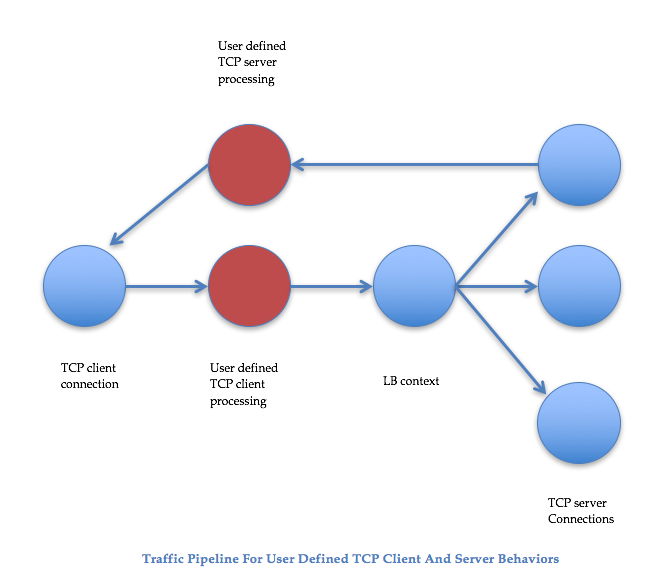Protocol extensions - traffic pipeline for user defined TCP client and server behaviors
The following figure illustrates the sample protocol extension - traffic pipeline for user defined TCP client and server behaviors

Add a custom protocol by using protocol extensions
The command line interface (CLI) commands for custom protocol use the keyword “user” to signify the user defined nature of the underlying configuration entities. With the help of extension code, you can add a new user protocol to the system and add user virtual servers for user-defined protocols. The user virtual servers are in turn configurable by setting parameters. Configured values for virtual server parameters are available in the extension code.
The following example illustrates the user flow for adding support for a new protocol. The example adds MQTT protocol support to the system. MQTT is a machine-to-machine “Internet of Things” connectivity protocol. It is a lightweight publish/subscribe messaging transport. Useful for connections with remote locations, this protocol uses client and broker tools to publish messages to subscribers.
1. Import the MQTT protocol extension implementation file to Citrix ADC system. The code listing for mqtt.lua is given below. The example below imports the MQTT extension file hosted on a webserver.
import extension http://10.217.24.48/extensions/mqtt.lua mqtt_code
2. Add a new user TCP based protocol to the system using the extension.
add user protocol MQTT -transport TCP -extension mqtt_code
3. Add a user load balancing vserver and bind backend services to it.
add service mqtt_svr1 10.217.24.48 USER_TCP 1501
add service mqtt_svr2 10.217.24.48 USER_TCP 1502
add lb vserver mqtt_lb USER_TCP –lbmethod USER_TOKEN
bind lb vserver mqtt_lb mqtt_svr1
bind lb vserver mqtt_lb mqtt_svr2
<!--NeedCopy-->
4. Add a user vserver for the newly added protocol. Set the defaultlb to the LB vserver configured above.
add user vserver mqtt_vs MQTT 10.217.24.28 8765 -defaultLb mqtt_lb
5. Optionally, enable MQTT session persistence based on ClientID, set the persistence type to USERSESSION.
set lb vserver mqtt_lb -persistenceType USERSESSION
The official version of this content is in English. Some of the Cloud Software Group documentation content is machine translated for your convenience only. Cloud Software Group has no control over machine-translated content, which may contain errors, inaccuracies or unsuitable language. No warranty of any kind, either expressed or implied, is made as to the accuracy, reliability, suitability, or correctness of any translations made from the English original into any other language, or that your Cloud Software Group product or service conforms to any machine translated content, and any warranty provided under the applicable end user license agreement or terms of service, or any other agreement with Cloud Software Group, that the product or service conforms with any documentation shall not apply to the extent that such documentation has been machine translated. Cloud Software Group will not be held responsible for any damage or issues that may arise from using machine-translated content.
DIESER DIENST KANN ÜBERSETZUNGEN ENTHALTEN, DIE VON GOOGLE BEREITGESTELLT WERDEN. GOOGLE LEHNT JEDE AUSDRÜCKLICHE ODER STILLSCHWEIGENDE GEWÄHRLEISTUNG IN BEZUG AUF DIE ÜBERSETZUNGEN AB, EINSCHLIESSLICH JEGLICHER GEWÄHRLEISTUNG DER GENAUIGKEIT, ZUVERLÄSSIGKEIT UND JEGLICHER STILLSCHWEIGENDEN GEWÄHRLEISTUNG DER MARKTGÄNGIGKEIT, DER EIGNUNG FÜR EINEN BESTIMMTEN ZWECK UND DER NICHTVERLETZUNG VON RECHTEN DRITTER.
CE SERVICE PEUT CONTENIR DES TRADUCTIONS FOURNIES PAR GOOGLE. GOOGLE EXCLUT TOUTE GARANTIE RELATIVE AUX TRADUCTIONS, EXPRESSE OU IMPLICITE, Y COMPRIS TOUTE GARANTIE D'EXACTITUDE, DE FIABILITÉ ET TOUTE GARANTIE IMPLICITE DE QUALITÉ MARCHANDE, D'ADÉQUATION À UN USAGE PARTICULIER ET D'ABSENCE DE CONTREFAÇON.
ESTE SERVICIO PUEDE CONTENER TRADUCCIONES CON TECNOLOGÍA DE GOOGLE. GOOGLE RENUNCIA A TODAS LAS GARANTÍAS RELACIONADAS CON LAS TRADUCCIONES, TANTO IMPLÍCITAS COMO EXPLÍCITAS, INCLUIDAS LAS GARANTÍAS DE EXACTITUD, FIABILIDAD Y OTRAS GARANTÍAS IMPLÍCITAS DE COMERCIABILIDAD, IDONEIDAD PARA UN FIN EN PARTICULAR Y AUSENCIA DE INFRACCIÓN DE DERECHOS.
本服务可能包含由 Google 提供技术支持的翻译。Google 对这些翻译内容不做任何明示或暗示的保证,包括对准确性、可靠性的任何保证以及对适销性、特定用途的适用性和非侵权性的任何暗示保证。
このサービスには、Google が提供する翻訳が含まれている可能性があります。Google は翻訳について、明示的か黙示的かを問わず、精度と信頼性に関するあらゆる保証、および商品性、特定目的への適合性、第三者の権利を侵害しないことに関するあらゆる黙示的保証を含め、一切保証しません。
ESTE SERVIÇO PODE CONTER TRADUÇÕES FORNECIDAS PELO GOOGLE. O GOOGLE SE EXIME DE TODAS AS GARANTIAS RELACIONADAS COM AS TRADUÇÕES, EXPRESSAS OU IMPLÍCITAS, INCLUINDO QUALQUER GARANTIA DE PRECISÃO, CONFIABILIDADE E QUALQUER GARANTIA IMPLÍCITA DE COMERCIALIZAÇÃO, ADEQUAÇÃO A UM PROPÓSITO ESPECÍFICO E NÃO INFRAÇÃO.
